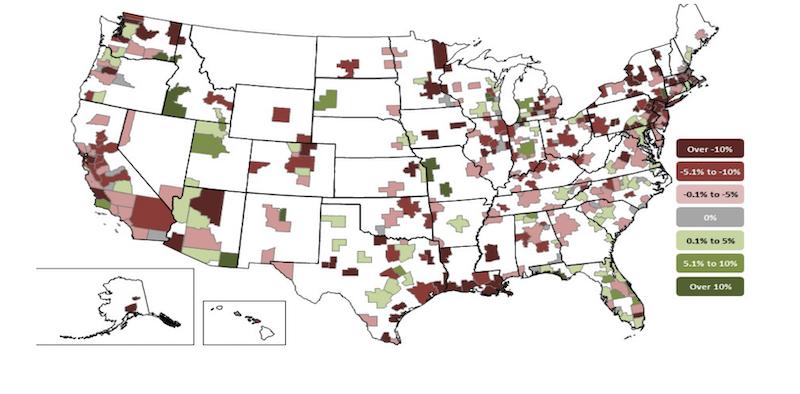Construction employment in July remained below the levels reached before the pre-pandemic peak in February 2020 in 36 states, according to an analysis by the Associated General Contractors of America of government employment data released today. Association officials said construction employment would benefit from new federal infrastructure investments and urged the House to quickly pass the bipartisan infrastructure bill.
“This data shows that full recovery remains elusive for construction in most states,” said Ken Simonson, the association’s chief economist. “In fact, the fast-spreading COVID-19 delta variant may make it harder to find employees eligible to work on restricted sites and may also depress demand if some owners defer projects.”
From February 2020—the month before the pandemic caused project shutdowns and cancellations—to last month, construction employment increased in only 14 states and was flat in the District of Columbia. Texas shed the most construction jobs over the period (-56,200 jobs or -7.2%), followed by New York (-52,600 jobs, -12.9%) and California (-35,100 jobs, -3.8%). Louisiana recorded the largest percentage loss (-15.3%, -21,000 jobs), followed by Wyoming (-13.5%, -3,100 jobs) and New York.
Of the states that added construction jobs since February 2020, Utah added the most (7,900 jobs, 6.9%), followed by North Carolina (5,700, 2.4%) and Idaho (4,400 jobs, 8.2%). The largest percentage gain was in Idaho, followed by South Dakota (7.5%, 1,800 jobs) and Utah.
From June to July construction employment decreased in 18 states, increased in 30, and was unchanged in Kansas, Tennessee, and D.C. The largest decline over the month occurred in Colorado, which lost 1,600 construction jobs or 0.9%, followed by a loss of 1,500 jobs each in Oklahoma (-1.9%), Texas (-0.2%), and Pennsylvania (0.6%). The steepest percentage declines since June occurred in New Hampshire (-2.2%, -600 jobs), followed by 1.9% losses in Oklahoma and Arkansas (-1,000 jobs).
North Carolina added the most construction jobs between June and July (4,300 jobs, 1.8%), followed by New Jersey (4,000 jobs, 2.7%) and Illinois (3,700 jobs, 1.7%). The largest percentage gains were in New Jersey and Connecticut (2.7%, 1,500 jobs), followed by South Carolina (2.4%, 2,600 jobs).
Association officials warned that construction employment was being impacted in many parts of the country because of supply chain challenges and growing market uncertainty caused by the resurgent Delta variant. They said new federal infrastructure investments would provide a needed boost in demand and help put more people to work in construction careers.
“New federal infrastructure investments will help put more people to work in high-paying construction careers,” said Stephen E. Sandherr, the association’s chief executive officer. “The House can help put Americans back to work by immediately approving the infrastructure measure that passed the Senate with broad, bipartisan support.”
View state February 2020-July 2021 data and rankings, 1-month rankings.c
Related Stories
Market Data | Oct 17, 2022
Calling all AEC professionals! BD+C editors need your expertise for our 2023 market forecast survey
The BD+C editorial team needs your help with an important research project. We are conducting research to understand the current state of the U.S. design and construction industry.
Market Data | Oct 14, 2022
ABC’s Construction Backlog Indicator Jumps in September; Contractor Confidence Remains Steady
Associated Builders and Contractors reports today that its Construction Backlog Indicator increased to 9.0 months in September, according to an ABC member survey conducted Sept. 20 to Oct. 5.
Market Data | Oct 12, 2022
ABC: Construction Input Prices Inched Down in September; Up 41% Since February 2020
Construction input prices dipped 0.1% in September compared to the previous month, according to an Associated Builders and Contractors analysis of U.S. Bureau of Labor Statistics’ Producer Price Index data released today.
Laboratories | Oct 5, 2022
Bigger is better for a maturing life sciences sector
CRB's latest report predicts more diversification and vertical integration in research and production.
Market Data | Aug 25, 2022
‘Disruptions’ will moderate construction spending through next year
JLL’s latest outlook predicts continued pricing volatility due to shortages in materials and labor
Market Data | Aug 2, 2022
Nonresidential construction spending falls 0.5% in June, says ABC
National nonresidential construction spending was down by 0.5% in June, according to an Associated Builders and Contractors analysis of data published today by the U.S. Census Bureau.
Market Data | Jul 28, 2022
The latest Beck Group report sees earlier project collaboration as one way out of the inflation/supply chain malaise
In the first six months of 2022, quarter-to-quarter inflation for construction materials showed signs of easing, but only slightly.
Hotel Facilities | Jul 28, 2022
As travel returns, U.S. hotel construction pipeline growth follows
According to the recently released United States Construction Pipeline Trend Report from Lodging Econometrics (LE), the total U.S. construction pipeline stands at 5,220 projects/621,268 rooms at the close of 2022’s second quarter, up 9% Year-Over-Year (YOY) by projects and 4% YOY by rooms.
Codes and Standards | Jul 22, 2022
Hurricane-resistant construction may be greatly undervalued
New research led by an MIT graduate student at the school’s Concrete Sustainability Hub suggests that the value of buildings constructed to resist wind damage in hurricanes may be significantly underestimated.
Market Data | Jul 21, 2022
Architecture Billings Index continues to stabilize but remains healthy
Architecture firms reported increasing demand for design services in June, according to a new report today from The American Institute of Architects (AIA).

















